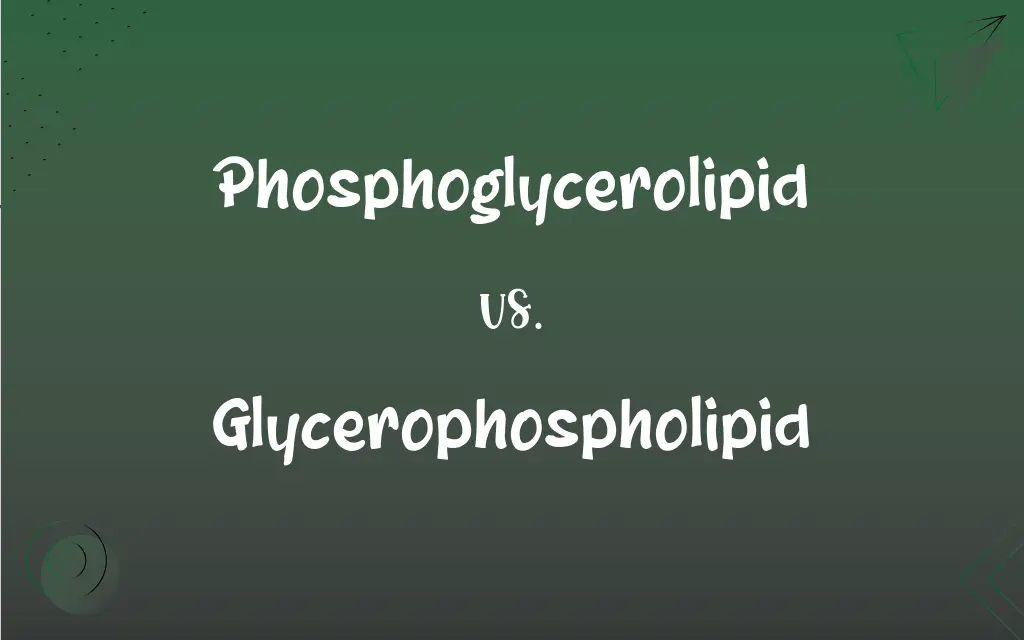Phosphoglycerolipid vs. Glycerophospholipid: What's the Difference?
By Aimie Carlson & Janet White || Updated on May 29, 2024
Phosphoglycerolipid refers to lipids containing glycerol and phosphate groups, while glycerophospholipid specifically describes a subtype of phosphoglycerolipids with glycerol bound to fatty acids and a phosphate group.

Key Differences
Phosphoglycerolipid is a broad term encompassing lipids that contain both glycerol and phosphate groups. These lipids play crucial roles in cell membrane structure and function. Glycerophospholipid, on the other hand, is a specific category within phosphoglycerolipids. It includes lipids where glycerol is esterified to two fatty acids and a phosphate group.
Phosphoglycerolipids are involved in various cellular processes, including signaling pathways. They form the basis of cell membranes by creating a bilayer structure. Glycerophospholipids, being a subtype, have similar functions but are more specifically involved in creating the bilayer structure of cell membranes due to their amphipathic nature, possessing both hydrophilic and hydrophobic regions.
Phosphoglycerolipids can vary in their fatty acid chains and the attached phosphate groups, leading to diversity in function and structure. Glycerophospholipids, such as phosphatidylcholine and phosphatidylethanolamine, are critical for membrane fluidity and are involved in signaling mechanisms.
The general structure of a phosphoglycerolipid includes a glycerol backbone, whereas glycerophospholipids not only have this backbone but also a defined structure where the glycerol is linked to two fatty acids and a phosphate group, often with an additional head group like choline or ethanolamine.
Comparison Chart
Definition
Lipids with glycerol and phosphate groups
Subtype of phosphoglycerolipids with specific structure
ADVERTISEMENT
General Structure
Glycerol backbone with phosphate groups
Glycerol with two fatty acids and a phosphate group
Function
Cell membrane structure, signaling
Membrane fluidity, signaling, structural integrity
Variability
Varies in fatty acids and phosphate attachments
Specific types like phosphatidylcholine, phosphatidylethanolamine
Example Types
Various types not strictly defined
Specific types within the phosphoglycerolipid category
Phosphoglycerolipid and Glycerophospholipid Definitions
Phosphoglycerolipid
Variable fatty acid chains.
Phosphoglycerolipids can have different lengths of fatty acid chains.
ADVERTISEMENT
Glycerophospholipid
Important for membrane fluidity.
Glycerophospholipids help maintain cell membrane fluidity.
Phosphoglycerolipid
Lipid molecule containing glycerol and phosphate.
Phosphoglycerolipids are essential for cell membrane integrity.
Glycerophospholipid
Involved in signaling mechanisms.
Glycerophospholipids play a role in cellular signal transduction.
Phosphoglycerolipid
Involved in cellular signaling pathways.
Phosphoglycerolipids participate in signaling across the cell membrane.
Glycerophospholipid
Subclass of phosphoglycerolipids with specific structure.
Glycerophospholipids are major components of biological membranes.
Phosphoglycerolipid
Broad class of lipids.
Phosphoglycerolipids include various subclasses of membrane lipids.
Glycerophospholipid
Contains glycerol, two fatty acids, and a phosphate group.
Glycerophospholipids have hydrophilic heads and hydrophobic tails.
Phosphoglycerolipid
Structural component of cell membranes.
The cell's outer layer comprises phosphoglycerolipids.
Glycerophospholipid
Examples include phosphatidylcholine and phosphatidylethanolamine.
Phosphatidylcholine is a well-known glycerophospholipid.
Phosphoglycerolipid
Glycerophospholipid
Glycerophospholipid
(organic chemistry) Any phospholipid based on glycerol.
FAQs
What is the function of phosphoglycerolipids in cells?
They provide structural integrity to cell membranes and are involved in signaling.
What are phosphoglycerolipids?
Phosphoglycerolipids are lipids containing glycerol and phosphate groups, forming key components of cell membranes.
Are all phosphoglycerolipids glycerophospholipids?
No, glycerophospholipids are a specific subset of phosphoglycerolipids.
What roles do glycerophospholipids play in cellular membranes?
They maintain membrane fluidity and participate in signaling processes.
Can phosphoglycerolipids vary in structure?
Yes, they can have different fatty acid chains and phosphate groups.
What are some examples of glycerophospholipids?
Phosphatidylcholine and phosphatidylethanolamine are examples.
Why are glycerophospholipids important for cells?
They are crucial for membrane structure and signaling functions.
How do phosphoglycerolipids contribute to membrane structure?
They form the bilayer structure of cell membranes.
How do glycerophospholipids differ from phosphoglycerolipids?
Glycerophospholipids are a specific type of phosphoglycerolipid with a glycerol backbone, two fatty acids, and a phosphate group.
What makes glycerophospholipids amphipathic?
Their structure includes both hydrophilic (phosphate head) and hydrophobic (fatty acid tails) regions.
What types of fatty acids are in phosphoglycerolipids?
They can include a variety of saturated and unsaturated fatty acids.
Do phosphoglycerolipids participate in signaling pathways?
Yes, they are involved in various cellular signaling pathways.
What is the main characteristic of glycerophospholipids in membranes?
Their ability to form stable bilayers that are flexible and dynamic.
Can glycerophospholipids be modified?
Yes, they can be modified to include different head groups, like choline or ethanolamine.
How do glycerophospholipids affect membrane fluidity?
Their structure allows for fluidity and flexibility in the membrane.
What structural feature is unique to glycerophospholipids?
The combination of a glycerol backbone with two fatty acids and a phosphate group.
Are phosphoglycerolipids only found in membranes?
Primarily, but they can also be involved in other cellular functions.
Are there diseases associated with phosphoglycerolipid dysfunction?
Yes, abnormalities in phosphoglycerolipids can be linked to certain diseases.
What is the role of phosphate in phosphoglycerolipids?
The phosphate group contributes to the lipid's amphipathic nature and signaling functions.
How do cells regulate glycerophospholipid composition?
Cells regulate the synthesis and turnover of glycerophospholipids to maintain membrane integrity and function.
About Author
Written by
Aimie CarlsonAimie Carlson, holding a master's degree in English literature, is a fervent English language enthusiast. She lends her writing talents to Difference Wiki, a prominent website that specializes in comparisons, offering readers insightful analyses that both captivate and inform.
Co-written by
Janet WhiteJanet White has been an esteemed writer and blogger for Difference Wiki. Holding a Master's degree in Science and Medical Journalism from the prestigious Boston University, she has consistently demonstrated her expertise and passion for her field. When she's not immersed in her work, Janet relishes her time exercising, delving into a good book, and cherishing moments with friends and family.































































